Memory Scaling on Haswell CPU, IGP and dGPU: DDR3-1333 to DDR3-3000 Tested with G.Skill
by Ian Cutress on September 26, 2013 4:00 PM ESTFor our single discrete GPU testing, rather than the 7970s which normally adorn my test beds (and were being used for other testing), I plumped for one of the HD 6950 cards I have. This ASUS DirectCU II card I purchased pre-flashed to 6970 specifications, giving a little more oomph. Typically discrete GPU options are not often cited as growth areas of memory testing, however we will let the results speak for themselves.
Dirt 3: Average FPS
Dirt 3 commonly benefits from boosts in both CPU and GPU power, showing near-perfect scaling in multi-GPU configurations. When using our HD6950 however there seems to be little difference between memory settings with no trend.
Dirt 3: Minimum FPS
Minimum frame rates show a different story – Dirt 3 seems to prefer setups with a lower CL – MHz does not seem to have any effect.
Bioshock Infinite: Average FPS
Single GPU frame rates for Bioshock has no direct effect for memory changes with less than 2% covering our range of tests.
Bioshock Infinite: Minimum FPS
One big sink in frame rates seems to be for 1333 C7, although given that C8 and C9 do not have this effect, I would presume that this is more a statistical outlier than an obvious trend.
Tomb Raider: Average FPS
Again, we see no obvious trend in average frame rates for a discrete GPU.
Tomb Raider: Minimum FPS
While minimum frame rates for Tomb Raider seem to have a peak (1600 C8) and a sink (2400 C12), this looks to be an exception rather than the norm, with minimum frame rates typically showing 35.8 – 36.0 FPS.
Sleeping Dogs: Average FPS
Frame rates for Sleeping Dogs vary between 49.3 FPS and 49.6 FPS, showing no distinct improvement for certain memory timings.
Sleeping Dogs: Minimum FPS
The final discrete GPU test shows a small 5% difference from 1600 C11 to 2400 C11, although other kits perform roughly in the middle.


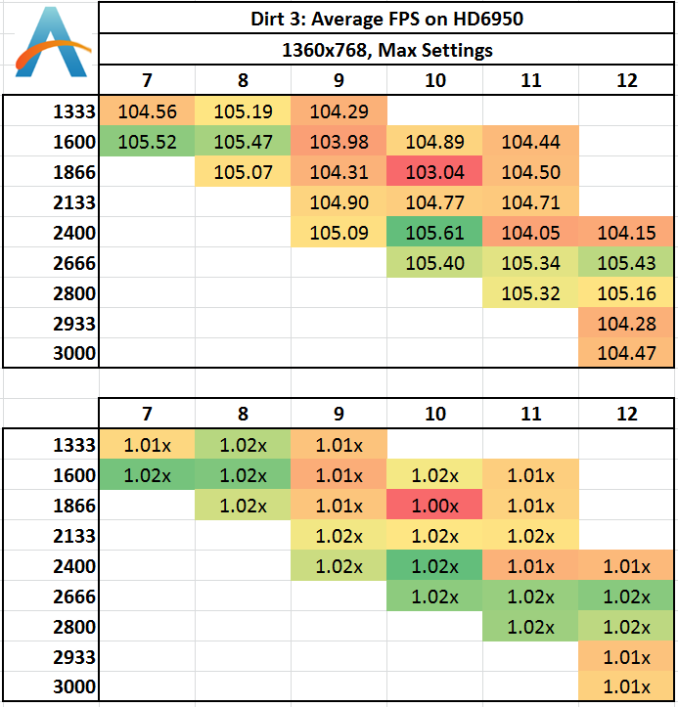
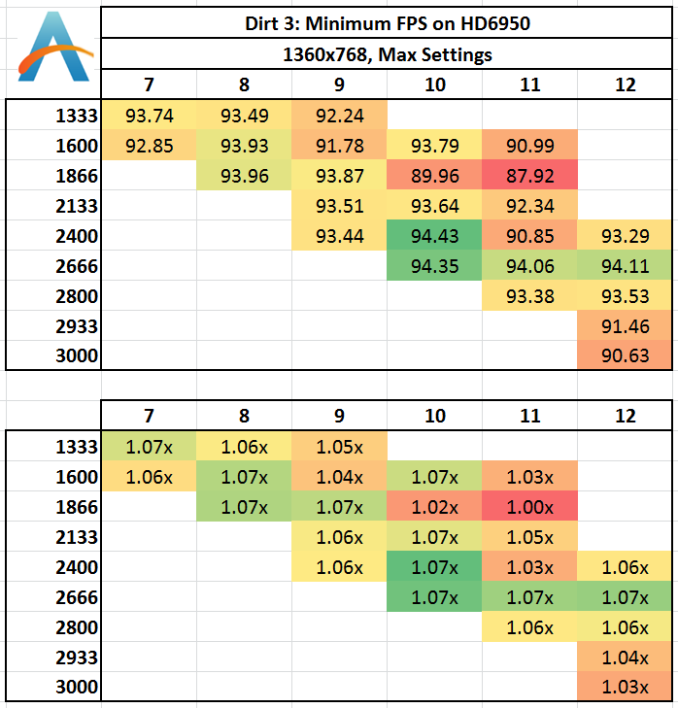
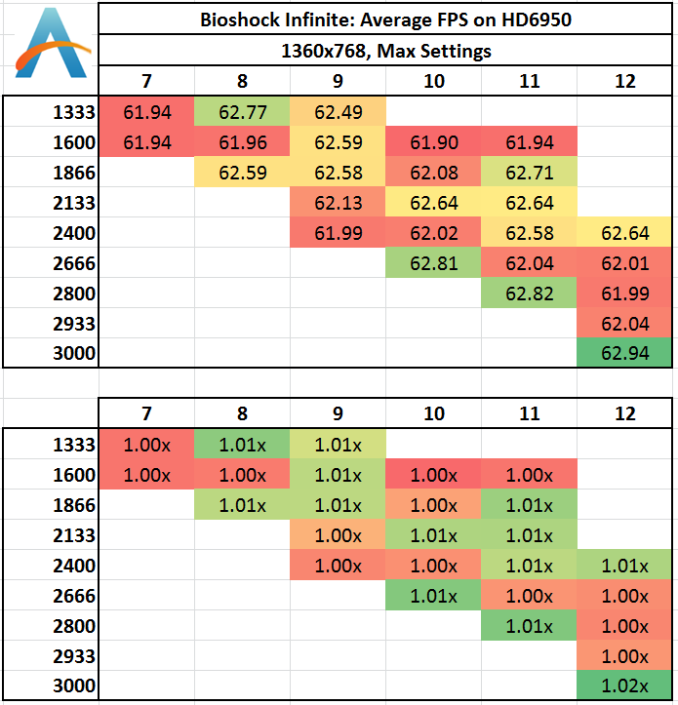
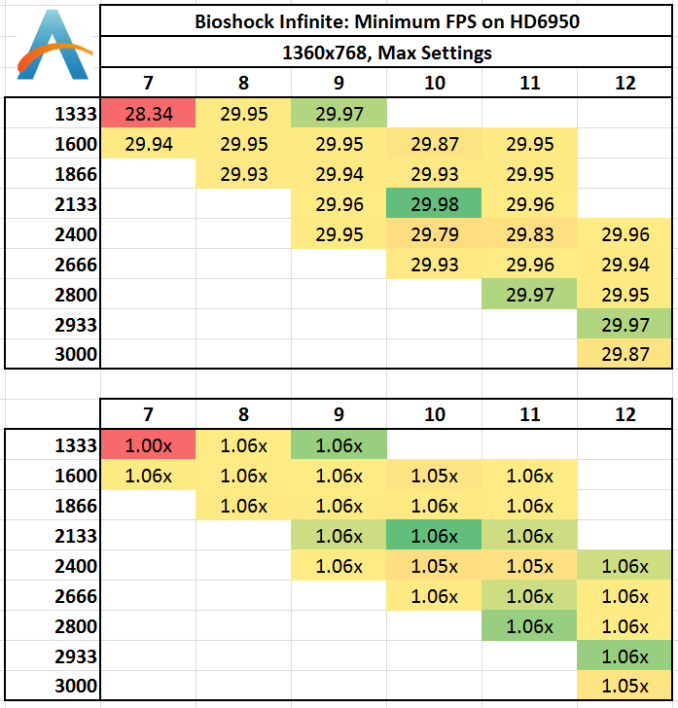
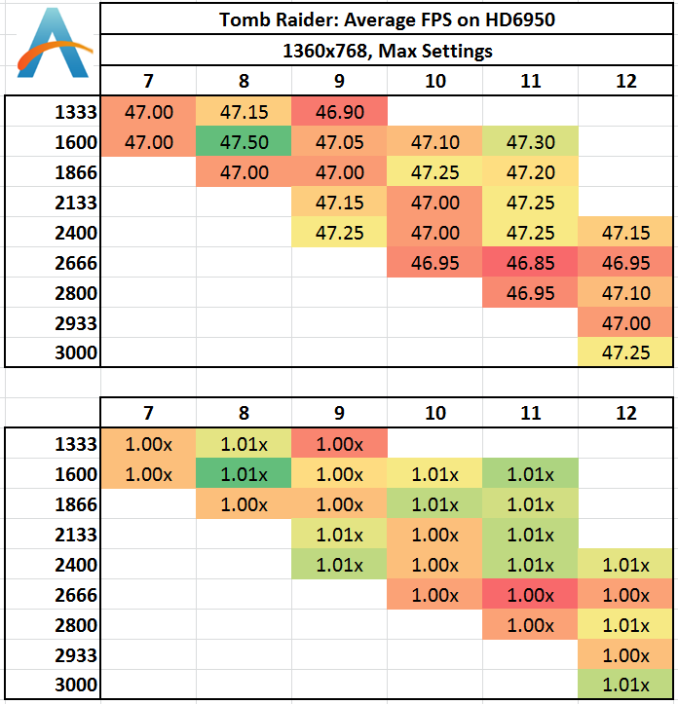
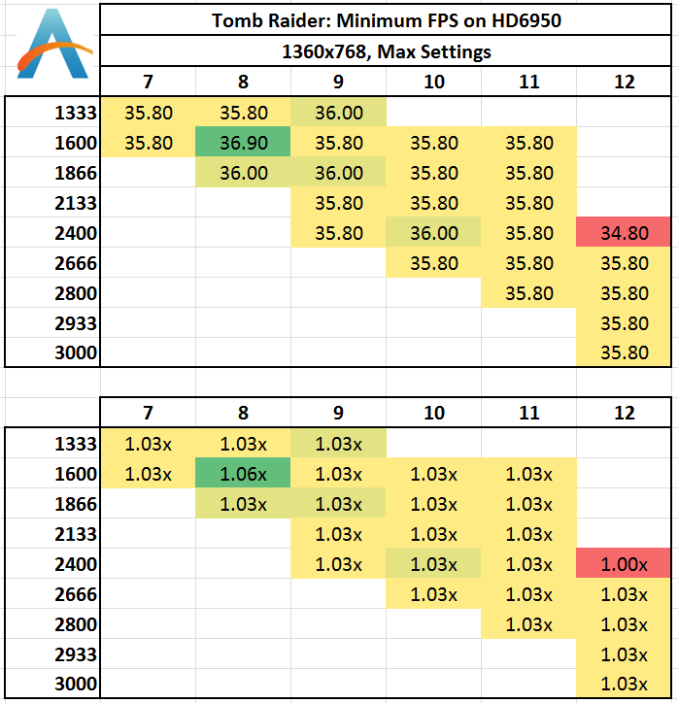
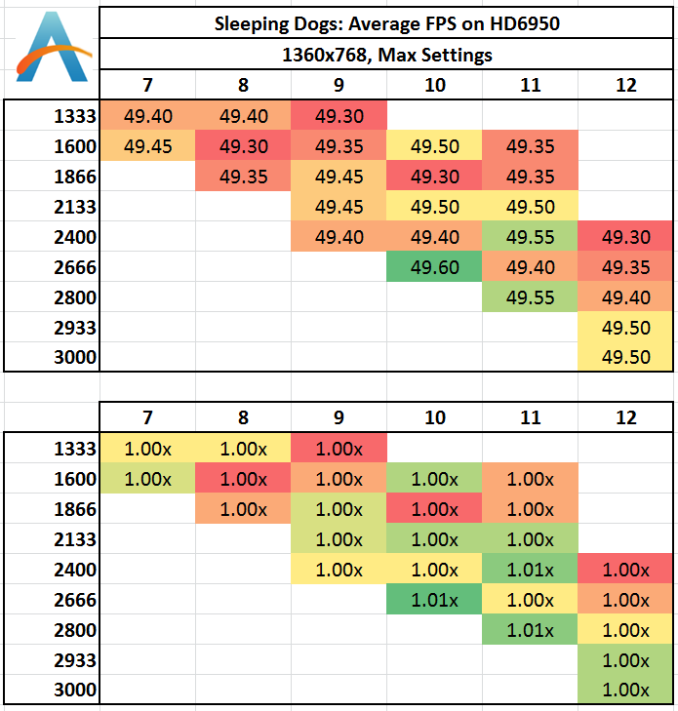
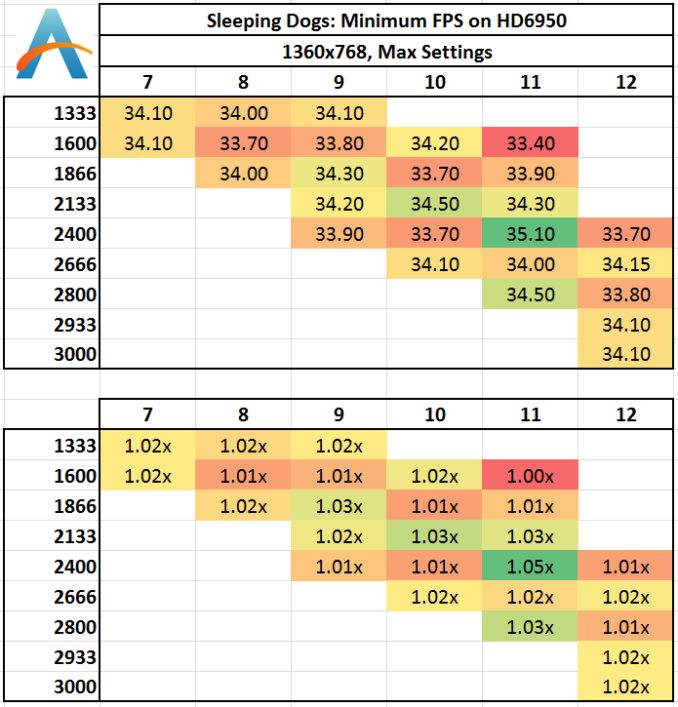








89 Comments
View All Comments
DanNeely - Thursday, September 26, 2013 - link
A suggestion for future articles of this type. If the results mostly show that really slow memory is bad but above that it doesn't really matter, normalizing data with a reasonably priced option that performs well as 1.0 might make clearer. ex for the current results put 1866-C9 as 1.0, and having 1333 as .9x and 3000 as 1.02. I think this would would help drive home that you're hitting diminishing returns on the cheap stuff.superjim - Thursday, September 26, 2013 - link
It looks like the days of 1600 C9 being the standard are over however the Hynix fire isn't helping faster memory prices any. 4-5 months ago you could get 2x 4GB of 1600 C9 for $30-35 bucks.Belial88 - Tuesday, October 1, 2013 - link
That's because just like when HDD prices skyrocketed due to the 2011 Thailand Flood, RAM prices have skyrocketed due to the 2013 Hynix Factory Fire. Prices had started to rise around early 2013 due to market consolidation and some other electronics (tablet, console, etc market needs), nothing huge, and they were actually starting to drop until the factory fire.As for 1600 C9 being some sort of standard, well, what Intel/AMD specifies as their rated RAM speed is no more useful than what they specify their CPU speed, as we know the chip can go way above that. JPeople who are savvy and know how to buy RAM, can buy RAM easily capable of 2400mhz CL8 by researching the RAM IC.
PSC/BBSE is easily capable of 2400mhz CL8 and generally costs ~$60 per 8gb (ie similar to the cheapest ddr3 ram). You can find some Hynix CFRs (double sided, unlike MFR, meaning they don't hit the high mhz numbers, but way better 24/7 performance clock for clock, kinda like dual channel vs single channel) for around $65, like the Gskill Ripjaws X 2400CL11 (currently like $75 on newegg), which will easily do ~2800mhzCL13.
RAM speed has always made an impact, the problem with reviews like the above is assuming you can't overclock RAM, and have to pay for it. In reality there is only ~5 different types of RAM (and a few subtypes). If you are smart and purchase Hynix, Samsung instead of Spektek, Qimonda, you can get RAM that easily does 2400mhz+ for the same or simliar price as the cheapest spekteks. If you assume that going from 1600 to 2400 will cost you $100+, of course it's a ripoff...
But if you buy, say, some Gskill Pi's 1600mhz for bargain bin, and overclock them to 2400CL8, you gain a good 10+ fps for almost nothing, and that's an awesome value. All RAM is just merely rebranded Spektek/Qimonda/PSC/BBSE/Hynix/Samsung, ie the same RAM is sold as 1600 CL9, 1600 CL8 1.65v, 1866 CL10, 2000CL11, 2133 CL12, etc ad nauesum.
vol7ron - Monday, September 30, 2013 - link
Relational results are helpful -I think they've been added since your comment- but I also like to see the empirical data as is also being listed.I know these things are currently being done in this article, I just want to make it a point not to make the decision to use one or the other, but both, again in the future.
vol7ron - Monday, September 30, 2013 - link
As an amendment, I want to add that the thing I would change in the future is the colors used. The spectrum should be green:good red:hazardous/bad. If you have something at 1.00x, perhaps that should be yellow, since it's the neutral starting position.alfredska - Monday, September 30, 2013 - link
Yes, this is some pretty basic stuff. It seems there's bouncing back and forth between green = good/bad right now. The author needs to stick to a convention throughout the article. I'm not really of the opinion that green and red are the best choices, but at least if a convention is used I can train my eyes.xTRICKYxx - Thursday, September 26, 2013 - link
It would be cool to see other IGP's including Iris Pro or HD 5000. Also, Richland may see slightly more than the 5% Haswell's HD 4600 has.Khenglish - Thursday, September 26, 2013 - link
I would expect richland/trinity to have larger gains since the IGP has access to only 4MB cache instead of 6MB or 8MB found on intel processors.yoki - Thursday, September 26, 2013 - link
hi, you said that the order of importance place amount of memory & their placement is most importance, but not a clue regarding how this scale in real world... for example i have 1600mhz 7Cl 6GB RAM in a x58 system,,,,should i upgrade it to 12GB ... how much i'll gain from thatIanCutress - Thursday, September 26, 2013 - link
That's ultimately up for the user to determine based on workload, gaming style, etc. I'd always suggest playing it safe, so if you plan on doing anything that would tax a system, 12gb might be a safe bet. That's X58 though, this is talking about Haswell, whose memory controller can take this high end kits ;)